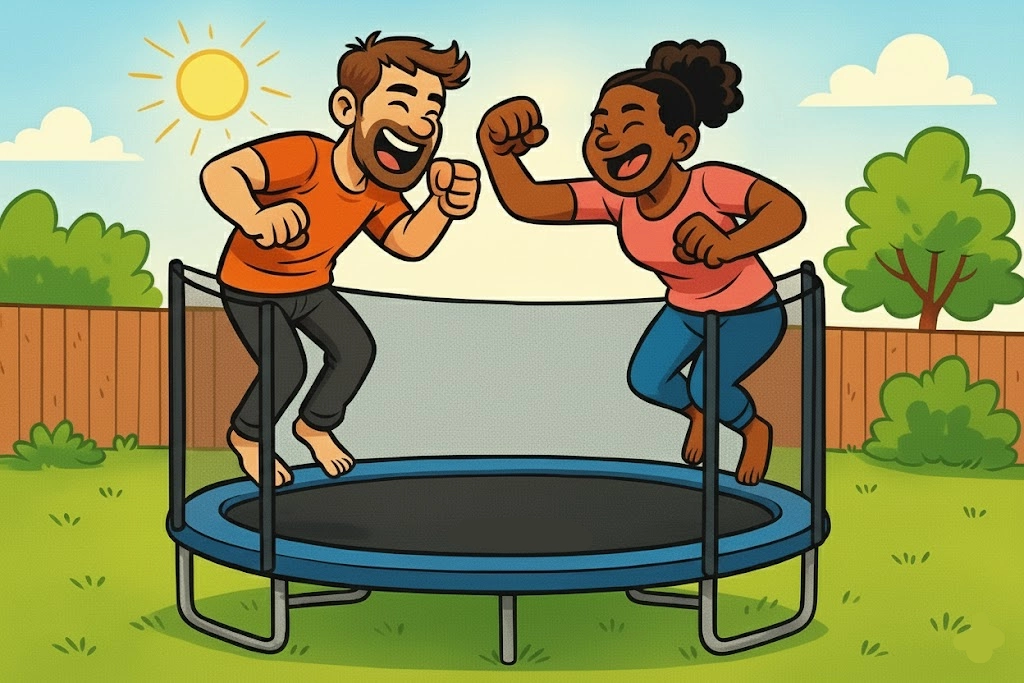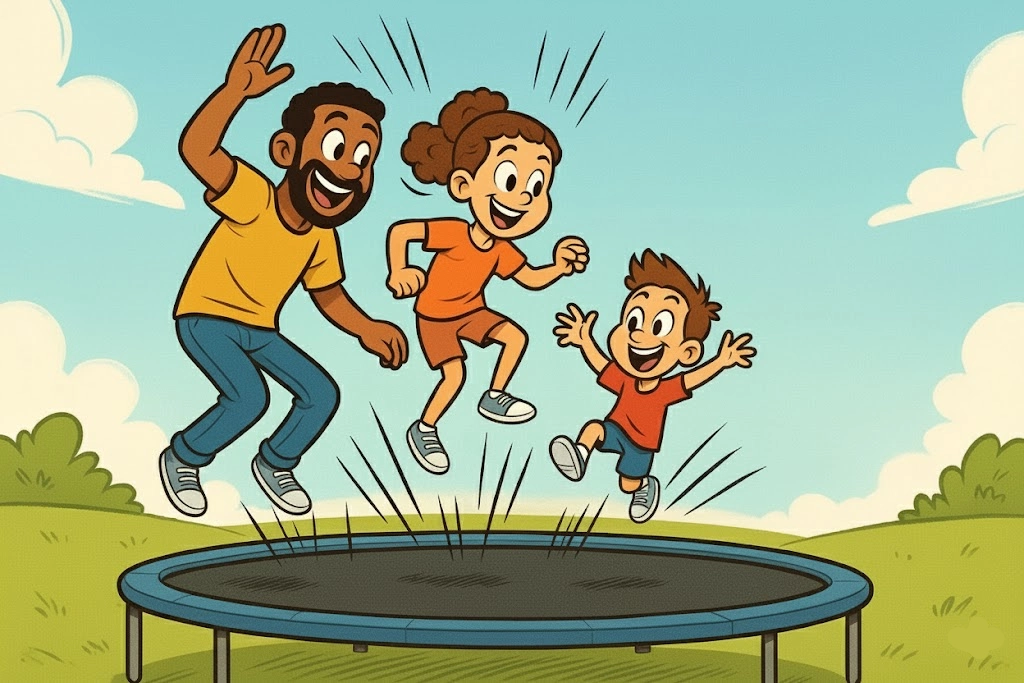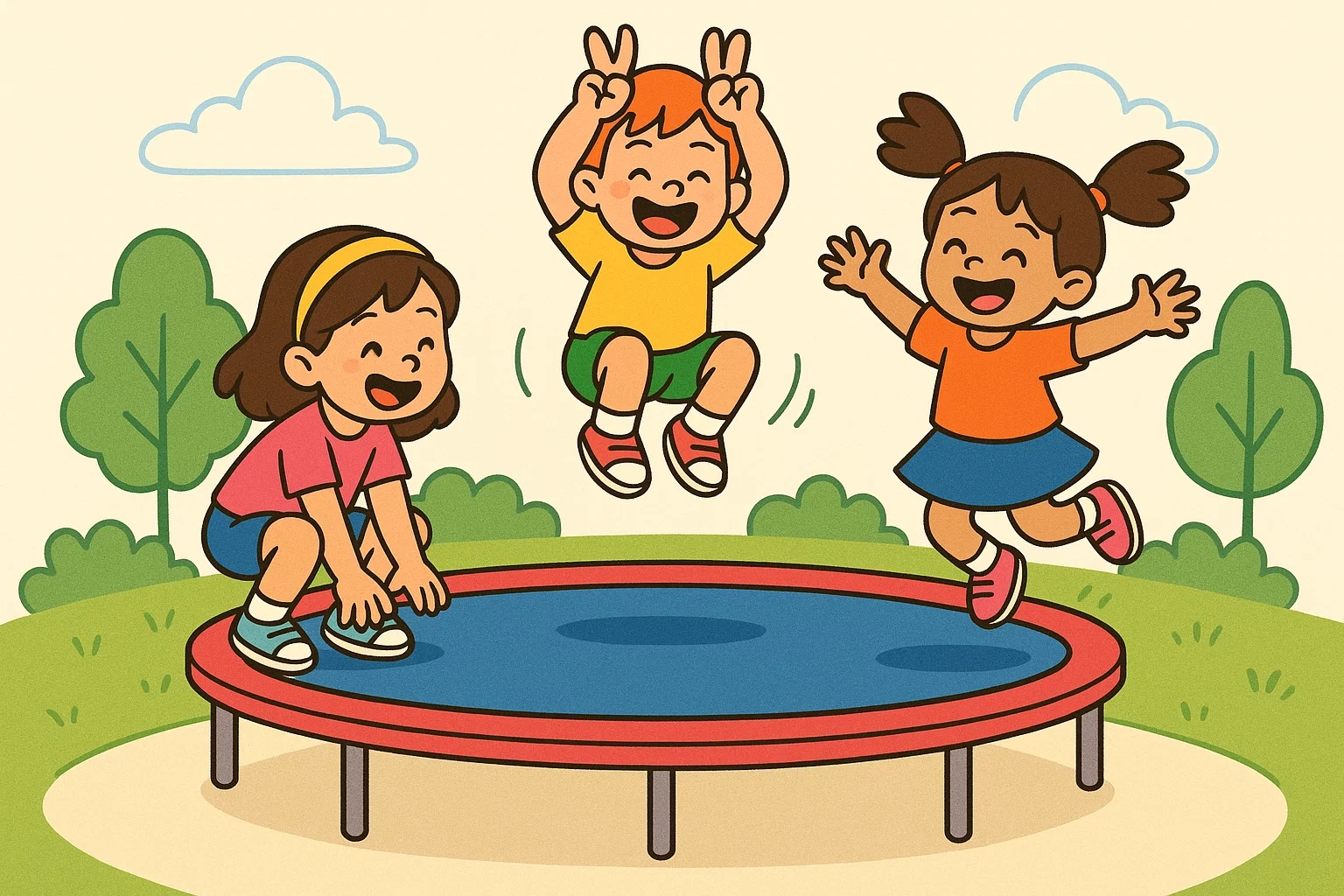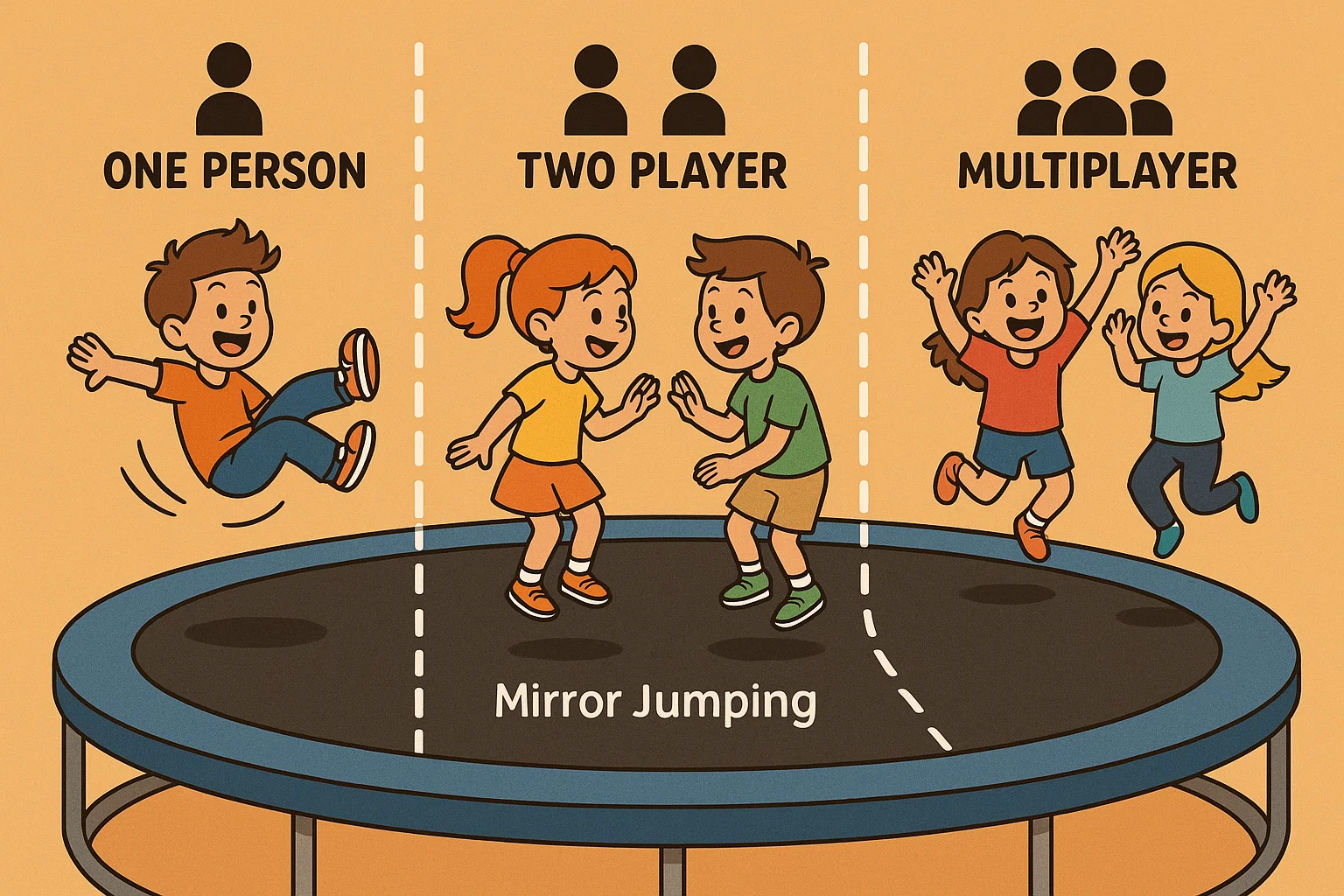Best Trampoline Jumping Games for Kids and Adults

Trampolines have evolved from simple backyard entertainment into versatile platforms for physical activity, social interaction, and skill development. Whether you’re looking to entertain younger kids on a Saturday afternoon or seeking fun games that adults and kids can enjoy together, the right trampoline game can transform ordinary bounce time into memorable experiences. This comprehensive guide explores the best trampoline games, safety considerations, and creative activities that keep everyone jumping.
Safety and Trampoline Use
Before diving into the fun-filled trampoline games available, establishing a foundation of safety practices ensures that trampoline time remains enjoyable for everyone involved. According to the American Academy of Pediatrics, trampoline-related injuries have decreased by approximately 15% in households that implement proper safety protocols and supervision.
Crucial Trampoline Safety Tips
Implementing consistent safety measures protects jumpers of all ages. The following guidelines create a safer environment for every trampoline session:
- Supervision Requirements: An adult should always monitor trampoline activities, particularly when children are jumping.
- Jumper Limitations: Allow only one person on the trampoline at a time whenever possible. When multiple jumpers are present, weight differences of more than 30 pounds between participants significantly increase collision risks.
- Equipment Inspection: Check the trampoline before each use for tears in the jumping surface, loose springs, or gaps in safety padding. Replace worn components immediately rather than postponing repairs.
- Clear Landing Zone: Maintain a clearance of at least 8 feet around the trampoline perimeter, free from trees, fences, or hard surfaces. This buffer zone prevents injuries if someone loses balance and falls off.
- Weather Awareness: Avoid using trampolines during wet conditions, as moisture creates slippery surfaces that compromise grip and control. Wind speeds exceeding 20 mph also pose safety concerns.
Benefits of Jumping Games and Activities
Trampoline activities offer substantial physical and developmental advantages beyond simple entertainment. Research posted on MDPI suggests that 10 minutes of jumping provides cardiovascular benefits comparable to 30 minutes of running, making it an efficient form of exercise.
- Physical Development: Jumping games naturally develop coordination and balance while building core strength and cardiovascular endurance. The repetitive nature of bouncing strengthens leg muscles and improves bone density in growing children.
- Cognitive Enhancement: Games that incorporate rules, sequences, or strategy—like Simon Says or obstacle course challenges—enhance executive function and working memory. Children who regularly engage in structured jumping activities show improved attention spans and problem-solving abilities.
- Social Skills: Multiplayer games teach turn-taking, cooperation, and healthy competition. These interactions help children develop emotional regulation as they navigate winning, losing, and sharing space with others.
- Energy Outlet: Trampolines provide an effective way to burn excess energy, particularly beneficial for high-energy children who need physical outlets. A typical 30-minute session can burn between 200-300 calories depending on intensity and body weight.
Choosing the Right Trampoline Equipment
Selecting appropriate equipment determines both safety and enjoyment levels. Different trampolines serve different purposes, and understanding these distinctions helps you make informed decisions.
| Trampoline Type | Best For | Key Features | Size Range |
| Round Trampolines | Families, recreational use | Centralized bounce, even tension | 8-15 feet diameter |
| Rectangular Trampolines | Advanced jumpers, gymnastics | Higher bounce, competitive use | 9×14 to 10×17 feet |
| Mini Trampolines | Young children, indoor use | Low height, safety handles | 3-5 feet diameter |
| In-Ground Trampolines | Permanent installation | Reduced fall height, aesthetic appeal | 10-14 feet diameter |
Safety Net Enclosures: A quality enclosure system attaches to the jumping mat rather than the frame, eliminating gaps where limbs could slip through. Look for nets with reinforced stitching and UV-resistant materials that withstand outdoor conditions.
Spring Padding: Thick padding covering all springs and the frame edge prevents pinching and impact injuries. Premium padding measures at least 1 inch thick and extends several inches over the springs.
Additional Accessories: Consider adding a basketball hoop designed specifically for trampoline use, which typically features soft materials and break-away rims. Weather covers protect your investment when the trampoline isn’t in use, extending equipment lifespan significantly.
Top Trampoline Games for Adults and Families

Trampoline fun isn’t exclusively for children—adults alike discover that jumping games provide excellent exercise and stress relief. The games listed here accommodate various fitness levels while encouraging family bonding.
Classic Jumping Games Everyone Loves
Some trampoline games have stood the test of time because they’re simple to understand yet endlessly entertaining. These classic game options require minimal setup and work well with mixed-age groups.
- Bounce Counting Challenge: Participants attempt to complete as many consecutive bounces as possible while maintaining proper form. This deceptively simple game builds endurance and helps jumpers develop consistent rhythm. You can increase difficulty by requiring specific landing positions or adding tuck jumps.
- Follow the Leader: One person performs a sequence of jumps, tricks, or movements that others must replicate. This game naturally scales to participant ability levels, as leaders can choose simple or complex sequences. It’s particularly effective for teaching new skills, as jumpers watch demonstrations before attempting them.
- Trampoline Twist: Players must add one new move to an ever-growing sequence, similar to a physical version of memory games. The first jumper does a seat drop, the second adds a knee drop, the third incorporates a spin, and so on. This great game combines memory skills with physical coordination.
- Cherry Bomb: One person sits in the center while another jumps nearby, creating bounce effects that “pop” the seated person upward. This activity should only involve participants of similar size and weight to prevent excessive force. Always enforce controlled jumping rather than aggressive bouncing.
High-Energy Games and Activities on the Trampoline
For those seeking to maximize physical exertion and cardiovascular benefits, these intense games and activities deliver challenging workouts disguised as play.
- Jump Rope on the Trampoline: Using a jump rope while bouncing combines two distinct motor skills, creating a challenging coordination exercise. Start with low bounces and gradually increase height as proficiency improves. This combination workout elevates heart rate more effectively than either activity alone.
- Popcorn: Younger kids sit cross-legged around the mat edge while one person jumps in the center, creating bouncing effects that make the seated players “pop” like kernels. Rotate jumpers every minute to ensure everyone gets both experiences. This game teaches cause-and-effect relationships while providing core strengthening for seated participants.
- Trampoline Tag: Designate one person as “it” who must tag others while everyone bounces. The elevated surface and bouncing mechanics make traditional chase dynamics completely different, requiring players to time jumps and anticipate movements. Set clear boundaries and rest periods to prevent exhaustion.
- Balance Challenges: Place soft objects on the trampoline that participants must navigate around while maintaining bouncing rhythm. Foam blocks, rolled towels, or soft toys create obstacles that require spatial awareness and agility. Progress to more complex patterns as skills improve.
Indoor Jumping Games When the Weather Doesn’t Cooperate
Mini trampolines and rebounders enable continued activity regardless of outdoor conditions. These adapted games suit indoor spaces while still providing substantial benefits.
- Seated Bounce Counting: Sitting on a mini trampoline while bouncing activates core muscles differently than standing jumps. Count consecutive bounces or set timed challenges to maintain engagement.
- Trampoline Dance Party: Play music and choreograph movements to the beat while bouncing. This combines cardiovascular exercise with rhythm training and creative expression. Younger children particularly enjoy this approach to structured movement.
- Target Toss: While bouncing, participants toss soft balls toward designated targets placed around the room. This game develops hand-eye coordination while maintaining cardiovascular activity. Adjust difficulty by varying target size and distance.
Fun Trampoline Games for Kids of All Ages

Children’s developmental stages require different activity types, and successful games acknowledge these variations. The following sections provide age-appropriate options that match cognitive and physical capabilities.
Simple Games for Kids to Boost Motor Skills
Fundamental movement patterns form the foundation for more complex activities later. These games emphasize skill development in enjoyable contexts.
- Colored Spot Landing: Attach weather-resistant colored circles to the trampoline mat and call out colors that children must land on. This game reinforces color recognition while developing controlled jumping and spatial awareness. You can adapt this concept using numbers, shapes, or letters for educational integration.
- Animal Jumps: Ask kids to jump like different animals—frog leaps, kangaroo bounces, or bunny hops. This imaginative play element increases engagement while teaching body control. Discussing each animal’s characteristics adds educational value to physical activity.
- Egg Crack: Children sit with knees tucked to chest (forming an “egg”) while someone else bounces nearby. The bouncing creates movement that eventually causes the “egg” to “crack” open. This activity strengthens core muscles and teaches spatial awareness.
- Trampoline Hopscotch: Recreate the classic game using chalk or tape on the trampoline surface. The bouncing element adds complexity to this familiar pattern, requiring better balance and coordination than ground-based hopscotch. This trampoline twist on traditional playground activities bridges familiar and novel experiences.
Creative Themed Activities
Themed activities capture imagination while providing structured play frameworks. These approaches work particularly well for extended trampoline sessions or parties.
- Space Station Astronaut Training: Create a narrative where the trampoline simulates zero gravity and children must complete “missions” involving specific jump types or sequences. This storytelling approach increases engagement duration and makes skill practice feel purposeful.
- Superhero Academy: Assign different jumps or tricks to superhero “powers” that students must master. The progression system inherent in this theme motivates continued practice and skill development.
- Ocean Adventure: The trampoline becomes a boat, island, or swimming area depending on game phases. Incorporate related activities like “fishing” for soft toys tossed onto the mat or “diving” through hula hoops held above the surface.
Essential Rules Before Kids Start Playing Games
Clear expectations prevent conflicts and maintain safety throughout play sessions. Establish these guidelines before any trampoline activity begins.
- Entry and Exit Protocols: Teach children to enter and exit using designated access points rather than climbing over the safety net or frame. This single habit prevents a significant percentage of entanglement injuries.
- No Roughhousing: Explicitly prohibit pushing, wrestling, or other aggressive behaviors on the trampoline. These actions dramatically increase injury risk in an already dynamic environment.
- Rest Periods: Mandate 5-minute breaks after every 20 minutes of jumping to prevent fatigue-related accidents. Tired jumpers lose coordination and make poor decisions regarding their capabilities.
- Age-Appropriate Challenges: Discourage younger kids from attempting tricks beyond their developmental readiness, even if older children perform them successfully. Each child progresses at their own pace, and comparisons undermine confidence while increasing risk.
Types of Trampoline Games Grouped by Players

Different group sizes suit different game formats. This organizational approach helps you quickly identify appropriate activities for your current situation.
One-Person Trampoline Games
Solo activities develop individual skills while providing flexibility for independent play. These games don’t require scheduling coordination or multiple participants.
- Skill Progression Practice: Work systematically through increasingly difficult jump sequences, from basic bounces to seat drops, knee drops, and eventually front flips (with proper training and safety measures). Document progress to visualize improvement over time.
- Bounce Time Trials: Set timers for endurance challenges—how long can you maintain consistent bouncing without breaks? Track personal records and attempt to beat previous achievements.
- Height Challenges: Mark or measure maximum bounce height and attempt to reach specific targets. This goal-oriented approach provides clear success metrics that motivate continued effort.
- Movement Meditation: Use rhythmic bouncing as a form of moving meditation, focusing on breath coordination and body awareness. This application helps children develop self-regulation skills and body-mind connections.
Exciting Games for Two Players
Two-player formats introduce social elements while keeping interactions manageable. These games for two work particularly well for siblings or playdates.
- Mirror Jumping: Partners face each other and take turns leading, with the follower matching all movements as precisely as possible. This activity develops observation skills and body awareness while building social connection through synchronized movement.
- Bounce Pattern Creation: One player creates a bouncing pattern using different areas of the mat, which the other must memorize and replicate. This game strengthens working memory and spatial reasoning.
- Trampoline Tennis: Using a soft ball and hands as “rackets,” players volley back and forth while bouncing. The game naturally teaches anticipation and reaction timing. Keep score using traditional tennis or volleyball rules for added structure.
- Complementary Challenges: Players work together to achieve combined goals—one counts while the other performs a specific trick, or they alternate jumps to maintain continuous motion. These cooperative structures teach teamwork and shared achievement.
Multiplayer Games and Activities
Group activities maximize social benefits and often generate more enthusiasm than solo or paired options. The games offer different advantages depending on group dynamics.
- Trampoline Dodgeball: Using exclusively soft foam balls, players attempt to tag others while everyone bounces. Establish clear boundaries and implement frequent position rotations to ensure fair participation. This adaptation of dodgeball increases difficulty significantly due to the unstable surface, making it challenging even for athletic adults.
- Hot Potato: Pass a soft object around while music plays; whoever holds it when music stops must perform a designated jump or trick. This combines anticipation with physical skill execution and works well with large groups.
- Simon Says: Adapt this childhood classic to trampoline-specific movements—”Simon says do three seat drops” or “Simon says bounce on one foot.” The traditional game structure requires no explanation while teaching following directions and self-control.
- Trampoline Volleyball: String a soft net or rope across the middle and play modified volleyball using a beach ball or balloon. Lower net height and allow multiple bounces to accommodate skill levels. This game teaches teamwork, strategy, and communication.
Incorporating Ball Games on the Trampoline
Adding balls to trampoline play introduces new skill dimensions and creates countless game variations. Different ball types suit different purposes—from soft foam balls for safety to beach balls for younger kids learning basic catching skills.
Slam Dunk and Basketball Games
A trampoline basketball hoop transforms an ordinary trampoline into a high-flying court where gravity seems optional. These basketball games combine bouncing mechanics with ball handling for comprehensive skill development.
- Basic Trampoline Basketball: Mount an adjustable basketball hoop at the trampoline edge and take shots while bouncing. The elevated launch position allows even younger children to experience successful shots, building confidence and motivation. Start with lower heights and larger balls before progressing to regulation equipment.
- Around the World: Place multiple hoops at different positions around the trampoline perimeter and complete shots from each station. This variation increases spatial awareness and requires jumpers to adjust force and trajectory for different angles.
- Bounce-Pass-Shoot Sequences: For multiple players, create patterns requiring bouncing, catching a passed ball, and shooting—all while maintaining bounce rhythm. This complex coordination challenge entertains advanced players while building multiple skill sets simultaneously.
- Trick Shot Competition: Award points based on shot difficulty—regular shots earn one point, jumping shots earn three, and specific tricks (behind the back, eyes closed, etc.) earn five. This scoring system encourages creativity and risk-taking within safe parameters.
Dodgeball and Rebound Challenges
Dodgeball becomes an entirely different game when played on a bouncing surface. The unstable foundation and three-dimensional movement possibilities create dynamic gameplay that tests agility and reaction speed.
- Elimination Dodgeball: Players attempt to tag opponents with soft foam balls while avoiding incoming throws. Hit players sit at the mat edge until a teammate catches a ball, allowing one eliminated player to return. This format maintains engagement even for eliminated players.
- Rebound Catch: Throw a ball against the safety net and catch it while maintaining bouncing rhythm. Progress to more complex patterns like behind-the-back catches or mid-air retrieval. This solo activity effectively develops hand-eye coordination.
- Target Zone Dodgeball: Divide the trampoline into sections with different point values. Successfully hitting an opponent while they’re in high-value zones earns bonus points. This variation adds strategic positioning to standard dodgeball gameplay.
Trampoline Ball Catch Activities
Simple catch games teach fundamental skills while providing scalable difficulty. These activities suit wide age ranges through equipment and rule adjustments.
- Catch the Ball Challenge: Throw a ball progressively higher with each successful catch while maintaining bounce rhythm. This self-paced activity allows individual skill level accommodation and provides clear progress markers.
- Partner Toss: Two players on the trampoline (when safe to do so) pass a ball back and forth while bouncing. The unstable surface makes even simple catches challenging. Progress to using multiple balls or increasing throwing difficulty.
- Balloon Keep-Up: Using a balloon instead of a ball slows the game significantly, making it perfect for younger kids developing basic coordination. Challenge participants to prevent the balloon from touching the trampoline surface. The slow-moving balloon provides more reaction time while still requiring continuous attention.
- Basket Toss: Place a basket or bucket at the trampoline edge and attempt to land balls inside while bouncing. Vary distances and basket sizes to adjust difficulty. This activity combines jumping with precision throwing, developing both gross and fine motor skills.
Beyond Jumping: Fun Games and Activities
Trampolines accommodate diverse activities beyond traditional bouncing, expanding their utility and appeal. These alternatives provide options when energy levels don’t support active jumping or when variety is needed.
Activities Other Than Jumping You Can Do
- Trampoline Reading Nook: The gentle give of trampoline surfaces creates surprisingly comfortable reading spaces. Add pillows and blankets to transform the jumping area into a unique reading environment. This unexpected use encourages literacy while making reading feel special.
- Stargazing Platform: Evening trampoline sessions focused on astronomy create memorable experiences. The slight elevation and open view make trampolines excellent observation platforms. Discuss constellations while lying comfortably on the mat.
- Art Station: Secure paper to the trampoline mat and use washable markers or chalk for creative expression. The unusual surface adds novelty to standard art activities and makes cleanup simple with water play afterward.
- Outdoor Movie Theater: Project films onto a sheet hung near the trampoline, using the jumping surface as seating. This creates an entertainment experience that combines fresh air with relaxation.
Enhancing Trampoline Fun with Accessories
Strategic accessories multiply activity possibilities without requiring significant investment. The following additions expand play options substantially:
- Water Play Equipment: On hot days, add a sprinkler beneath or beside the trampoline for cooling fun. Water balloons become exciting targets or props for various games. Always supervise water activities carefully, as wet surfaces increase slip risks.
- Glow Equipment: For evening sessions, add glow sticks, LED balls, or string lights around the perimeter. These create a magical atmosphere while extending usable hours. Glow-in-the-dark games offer entirely different dynamics than daytime activities.
- Portable Goals and Targets: Beyond basketball hoops, consider soccer goals, toss targets, or ring toss setups. Multiple target options prevent boredom and encourage diverse skill development.
- Foam Shapes and Props: Large foam blocks, noodles, and shapes serve as obstacles, props, or game elements. Their soft construction maintains safety while adding tactical possibilities.
Recommended Further Reading and Related Games
Expanding your knowledge base helps you optimize trampoline experiences and identify new activity options. Consider exploring these resources:
- Physical Education Resources: Organizations like SHAPE America provide evidence-based information about children’s physical development and age-appropriate activities. Their guidelines help ensure activities match developmental readiness.
- Trampoline Safety Organizations: The International Association of Trampoline Parks and the American Society for Testing and Materials publish safety standards and recommendations. Staying current with these guidelines protects participants.
- Child Development Resources: Understanding developmental milestones helps you select appropriately challenging activities. Books like “The Whole-Brain Child” by Daniel Siegel explain how physical activities support cognitive and emotional growth.
- Related Outdoor Activities: Complement trampoline time with other outdoor activities like obstacle courses using playground equipment, playground games that develop similar skills, or swimming for non-impact cardiovascular exercise. This variety prevents overuse injuries while maintaining engagement.
